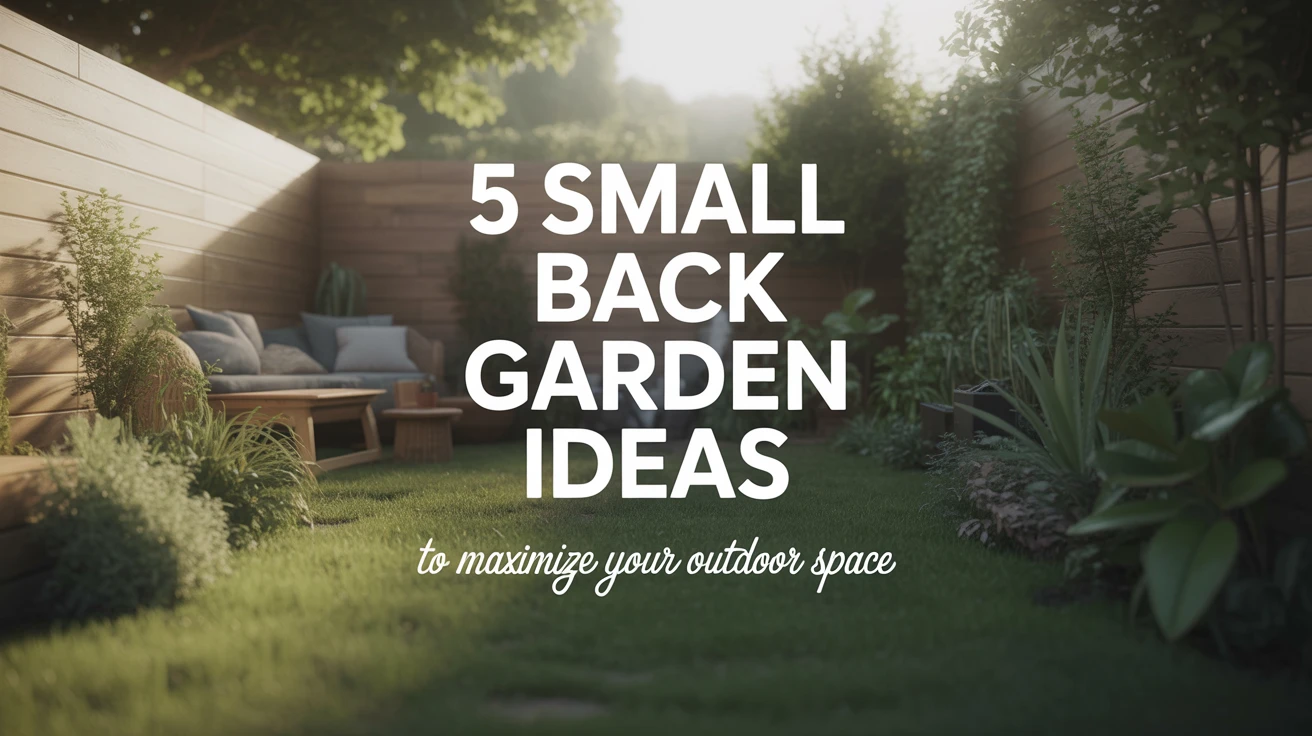
Introduction
When I first moved into my home with a compact back garden, I was initially disappointed by the limited space. However, I quickly discovered that small gardens can be just as beautiful and functional as larger ones – they just require a bit more creativity. Whether you have a tiny courtyard, a narrow balcony, or a modest backyard, there are countless ways to transform your outdoor area into a stunning and practical space.
In my years of designing and working with small back garden ideas, I’ve found that the key is to work smarter, not harder. By implementing strategic design principles and making thoughtful choices about layout, furniture, and planting, you can create an outdoor oasis that feels spacious and inviting, regardless of its actual dimensions.
Today, I’m sharing five of my favorite approaches that have consistently helped my clients (and myself!) make the most of limited outdoor spaces. These ideas aren’t just theoretical – they’re battle-tested solutions that I’ve personally implemented with great success.
1. Vertical Gardening: Growing Up Instead of Out

When I realized my own garden’s footprint was too small for all the plants I wanted, I discovered the game-changing potential of vertical gardening. By utilizing walls, fences, and other vertical surfaces, you can dramatically increase your planting area without sacrificing precious floor space.
Vertical gardening has transformed countless small back gardens I’ve worked on, creating lush green walls that add depth and interest while keeping the ground clear for other uses.
Effective Vertical Gardening Options:
- Wall-mounted planters – These come in various styles, from pocket planters to modular systems that allow you to create living walls.
- Trellises and arbors – Perfect for climbing plants like jasmine, clematis, or morning glories.
- Hanging baskets – Can be suspended from pergolas, eaves, or shepherd’s hooks.
- Repurposed pallets – With some waterproofing and soil pockets, these make excellent vertical planters.
- Tiered plant stands – These create multiple levels of planting in a small footprint.

View on AmazonAs an Amazon Associate, I earn from qualifying purchases.

View on AmazonAs an Amazon Associate, I earn from qualifying purchases.
Pro Tip: When selecting plants for vertical gardens, consider their mature size and growth habits. I once made the mistake of planting an aggressive climber (wisteria) in a small space, and it quickly became overwhelming. For easier maintenance, choose plants with similar water and light requirements for each vertical section.
2. Multi-Functional Furniture: Double-Duty Solutions
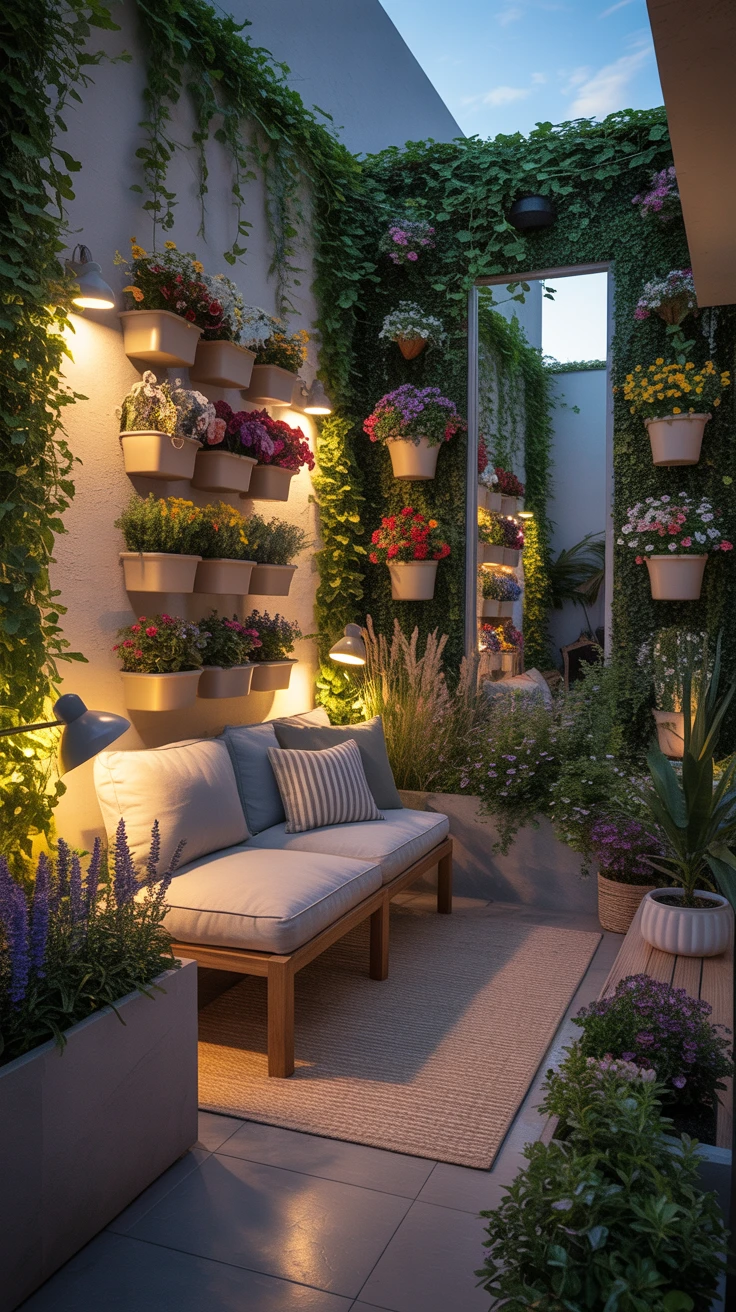
In small spaces, every item needs to earn its keep. I learned this lesson the hard way after cluttering my first small garden with too many single-purpose pieces. Now, I always recommend furniture that serves multiple functions.
Multi-functional pieces have become my secret weapon when designing small back garden ideas for clients with limited space but big entertainment needs.
Smart Furniture Choices for Small Gardens:
- Storage benches – Provide seating while hiding away gardening tools, cushions, or children’s toys.
- Folding or extendable tables – Can be expanded when hosting guests and collapsed when not in use.
- Nesting tables or stools – Tuck away neatly when not needed.
- Convertible pieces – Like ottomans that transform into tables or benches that become loungers.
- Wall-mounted drop-leaf tables – Fold down when needed and take up minimal space when not in use.

View on AmazonAs an Amazon Associate, I earn from qualifying purchases.

View on AmazonAs an Amazon Associate, I earn from qualifying purchases.
Pro Tip: Invest in weather-resistant materials like teak, aluminum, or high-quality synthetics. I once bought inexpensive wooden furniture for my garden to save money, only to replace it all after just two seasons. Quality pieces might cost more initially but will save you money and hassle in the long run.
3. Use of Mirrors: Creating Optical Illusions
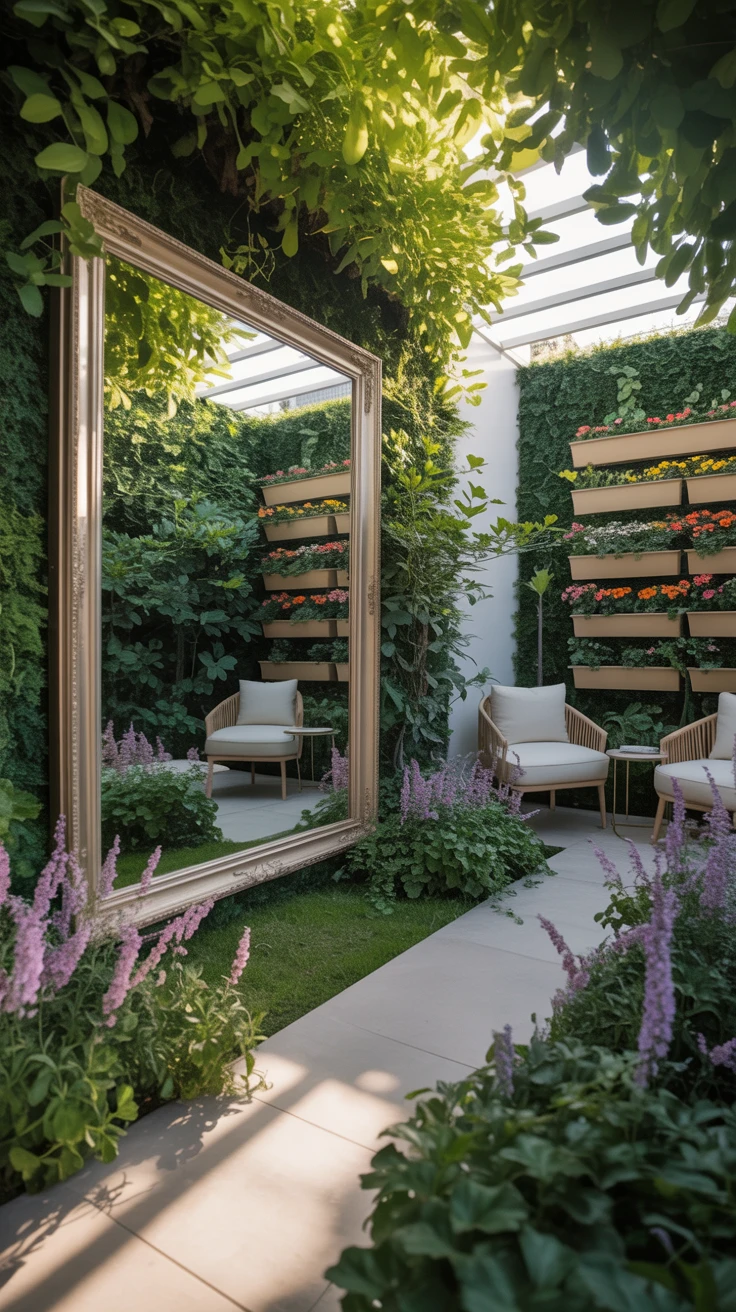
One of the most transformative tricks I’ve discovered for small gardens is the strategic use of mirrors. Just as they work indoors to make rooms feel larger, outdoor mirrors can create a stunning illusion of depth and space in confined areas.
The first time I installed a large mirror in a client’s tiny courtyard, even I was amazed at how it seemed to double the space. The garden instantly felt more expansive and light-filled.
Mirrors work by reflecting light and views, tricking the eye into perceiving more space than actually exists. They’re particularly effective when positioned to reflect greenery, creating the impression that the garden continues beyond its physical boundaries.

View on AmazonAs an Amazon Associate, I earn from qualifying purchases.

View on AmazonAs an Amazon Associate, I earn from qualifying purchases.
Pro Tip: When placing mirrors outdoors, ensure they’re properly sealed and designed for exterior use. Position them thoughtfully to avoid creating harsh reflections that might confuse birds or reflect direct sunlight into your home. I once installed a mirror that created a blinding reflection during certain hours – a mistake I quickly corrected by adjusting its angle slightly.
Creative Ways to Incorporate Mirrors:
- Frame mirrors like windows or doors to create “portals” to imaginary garden extensions
- Use mirrored tiles to create a mosaic effect on walls
- Place mirrors behind plants to create depth and multiply your greenery
- Install mirrored garden ornaments that reflect light and movement
- Consider convex mirrors to reflect a wider view of your garden
4. Container Gardening: Flexibility and Mobility
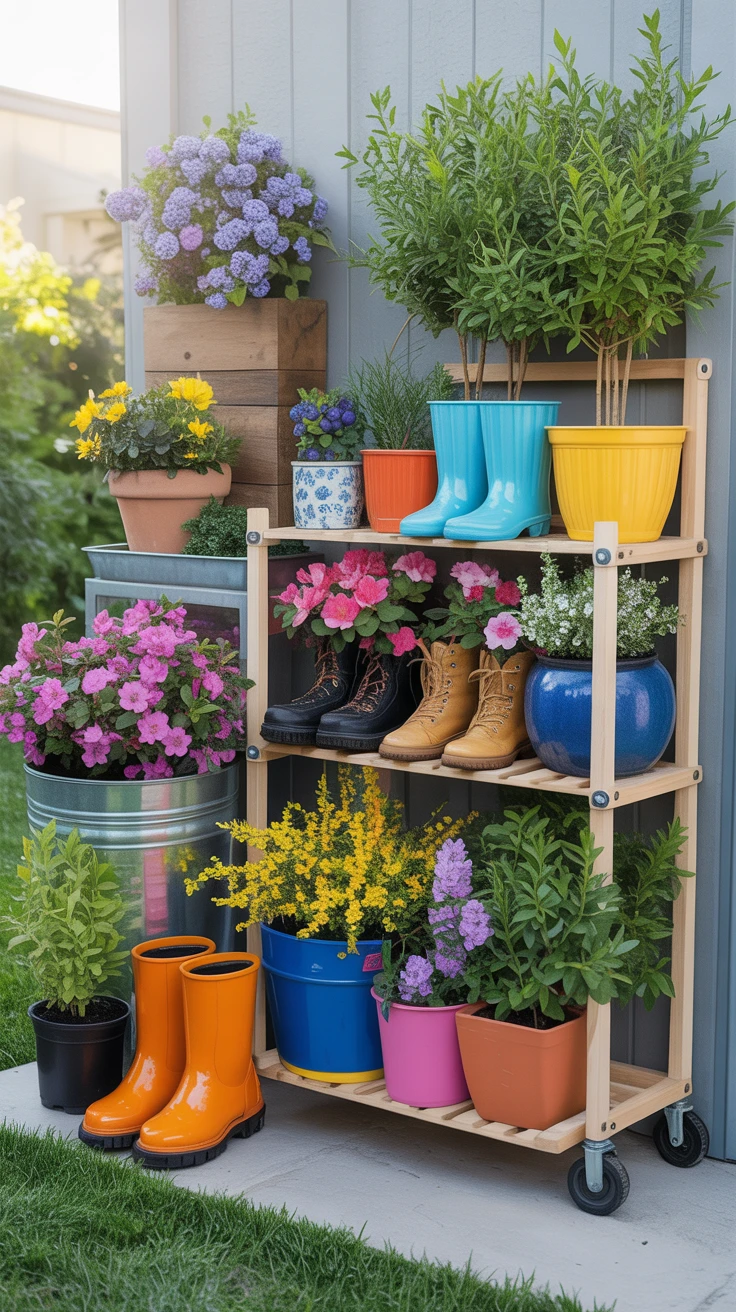
Container gardening revolutionized how I approach small back gardens. When space is limited, the ability to move and rearrange plants becomes invaluable. Plus, containers allow you to grow plants that might not thrive in your native soil.
I remember struggling with poor soil in my first garden until I embraced containers. Suddenly, I could grow acid-loving plants like blueberries and azaleas despite my alkaline soil, and I could rearrange my garden seasonally to highlight whatever was looking best.
Container Gardening Strategies:
- Use varying heights – Create visual interest by combining tall, medium, and low containers
- Group containers – Clustering pots creates greater impact than scattering them
- Consider wheeled planters – For larger containers that you’ll want to move regularly
- Explore unusual containers – Repurposed items like old sinks, boots, or toolboxes add character
- Try vertical container systems – Stacking planters or wall-mounted containers maximize space

View on AmazonAs an Amazon Associate, I earn from qualifying purchases.
Pro Tip: Container plants dry out faster than those in the ground. Install a simple drip irrigation system with a timer to ensure consistent watering, especially during hot weather. After losing several container plants during a vacation, I now use self-watering containers for many of my plants, which has been a game-changer for maintenance.
5. Lighting Solutions: Extending Garden Hours
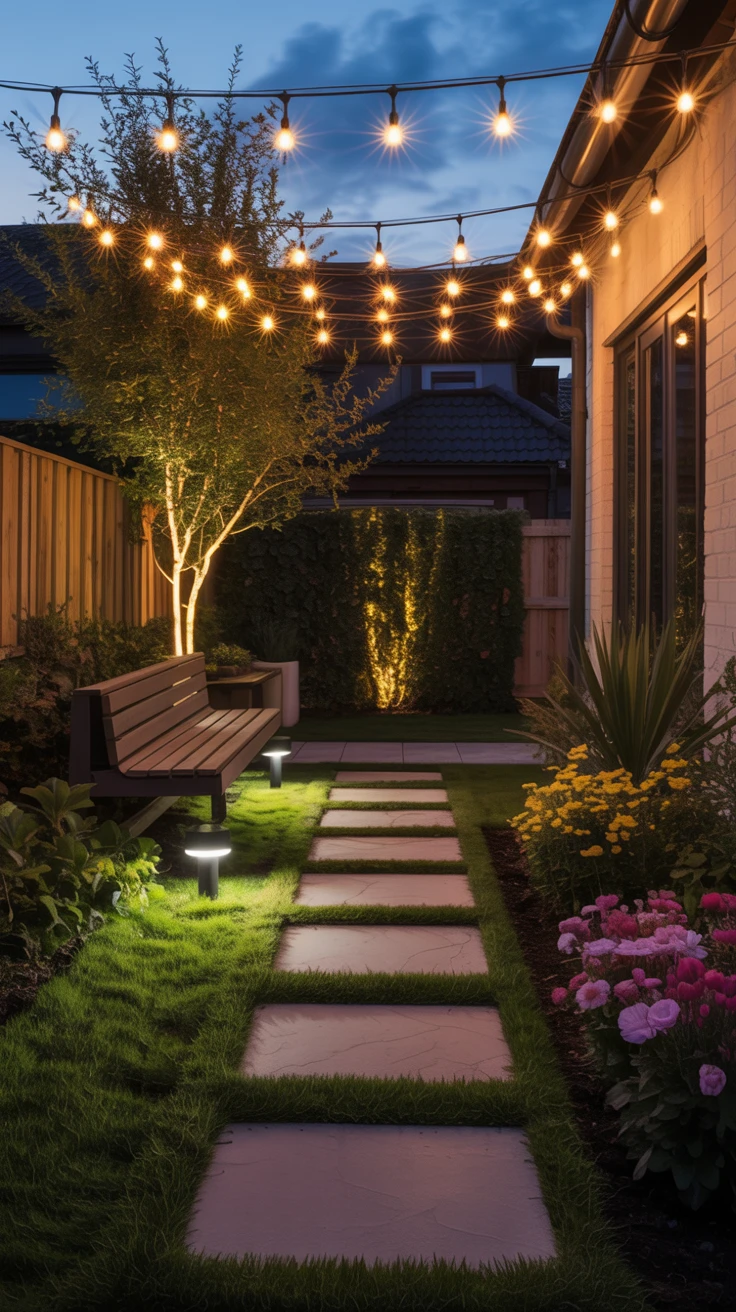
Proper lighting transformed my own small garden from a space I only enjoyed during daylight to an enchanting retreat I use well into the evening. Good lighting not only extends the usable hours of your garden but can also create the illusion of greater space by highlighting different zones and features.
I’ve found that layered lighting works best in small gardens, combining practical illumination with atmospheric effects. This approach maximizes the functionality and ambiance of limited outdoor areas.
Effective Garden Lighting Options:
- String lights – Create a magical canopy when strung overhead
- Solar path lights – Illuminate walkways without requiring electrical installation
- Uplighting – Highlights trees or architectural features, drawing the eye upward
- Spotlights – Focus attention on special plants or garden features
- LED strip lighting – Can be installed under benches or steps for subtle illumination

View on AmazonAs an Amazon Associate, I earn from qualifying purchases.

View on AmazonAs an Amazon Associate, I earn from qualifying purchases.
Pro Tip: Opt for warm white lighting (2700-3000K) rather than cool white or blue tones for a more inviting atmosphere. I once installed cool white lights in my garden and found the effect harsh and uninviting. Switching to warm white transformed the space into a cozy outdoor room.
Conclusion
Throughout my journey with small back garden ideas, I’ve discovered that limitations often spark the most creative solutions. Each of these five approaches—vertical gardening, multi-functional furniture, mirrors, container gardening, and strategic lighting—can dramatically transform even the tiniest outdoor space.
The beauty of these ideas is that they can be combined and adapted to suit your specific space, style, and needs. You might start with just one concept and gradually incorporate others as your garden evolves.
Remember, a small garden isn’t a compromise—it’s an opportunity to create an intimate, detailed space where every element matters. With thoughtful planning and these proven strategies, your compact outdoor area can become a favorite part of your home.
Frequently Asked Questions
What are the best plants for vertical gardening in small spaces?
For vertical gardens, I recommend plants with compact growth habits and those that naturally climb or trail. Great options include climbing jasmine, clematis, ivy, trailing petunias, strawberries, herbs like thyme and oregano, ferns, and succulents. Choose plants based on your light conditions—succulents for sunny spots and ferns for shadier areas.
How can I maintain a small garden with limited time?
Focus on low-maintenance plants suited to your climate, install automatic irrigation systems, use mulch to reduce weeding, choose perennials over annuals, and consider artificial grass for very small areas. Container gardening also allows for easier maintenance as you can control soil quality and positioning. I’ve found that spending 20 minutes twice a week on maintenance prevents bigger jobs from accumulating.
What materials work best for outdoor mirrors?
For outdoor mirrors, look for acrylic or stainless steel mirror products specifically designed for exterior use. These resist corrosion better than traditional glass mirrors. If using glass, ensure it’s properly sealed against moisture and securely mounted for safety. I prefer mirrors with frames treated for outdoor conditions, as they tend to weather better and look more intentional in the garden setting.
How do I choose the right size containers for my plants?
Consider the mature root size of your plants—larger plants like shrubs need at least 15-20 gallons, while herbs might need only 1-2 gallons. Ensure containers have drainage holes and are proportional to your space. I generally recommend going one size larger than you think necessary, as this reduces watering frequency and gives plants room to grow. Just be sure you can still move the container if needed.
Can these small garden ideas work in rental properties?
Absolutely! Most of these ideas can be implemented without permanent changes. Container gardening, freestanding vertical planters, portable lighting, and freestanding mirrors are all rental-friendly. For vertical gardening, use tension rods or freestanding trellises rather than permanent wall installations. I’ve helped many renters create stunning temporary gardens that they can take with them when they move.


